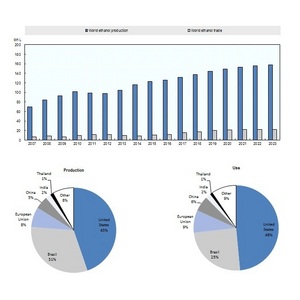OECD-FAO outlook report predicts growth in ethanol production

OECD-FAO Agricultural Outlook 2014
July 18, 2014
BY Erin Krueger
A new agricultural outlook report published by the Organization for Economic Co-operation and Development and the Food and Agricultural Organization of the United Nations predicts that the consumption and production of biofuels will increase significantly through 2023.
The report, titled “OECD-FAO Agricultural Outlook 2014,” predicts ethanol prices will increase in line with inflation rates and crude oil prices over the next decade. The report forecasts that world ethanol prices will increase by 9 percent in real terms through 2023. While biodiesel prices are also expected to increase, the analysis predicts the increase could be at a slower rate driven primarily by increased vegetable oil prices rather than crude oil prices.
According to the outlook, the OECD and FAO are predicting that global ethanol production will expand, reaching 158 billion liters (41.74 billion gallons) by 2023. The volume of production in developing countries is expected to increase from 45 billion liters in 2013 to 71 billion liters in 2023. In the U.S., ethanol production is forecast to increase from 50 billion liters in 2013 to 71 billion liters in 2023. The report predicts cellulosic ethanol production will reach 7.3 billion liters by 2023. In Brazil, ethanol production is expected to increase from 25 billion liters in 2013 to 50 billion liters in 2023. Brazilian net exports are expected to increase to 22.4-39 billion liters by 2023. Biodiesel production is expected to expand to 40 billion liters globally.
The report indicates that most biofuels will be produced from crop-based feedstocks, and that by 2023 12 percent of coarse grains, 28 percent of sugarcane and 14 percent of vegetable oil will be used to produce biofuels. Coarse grains and sugarcane are expected to remain the primary ethanol feedsocks through 2023. Cellulosic ethanol is expected to account for 5 percent of world ethanol production by 2023, with most produced in the U.S.
Advertisement
With regard to the U.S. industry, the outlook assumes that only 12 percent of the cellulosic mandate under the renewable fuel standard (RFS) will be implemented by 2023. According to the report, biodiesel is expected to help meet the advanced and total biofuel mandates of the RFS, with imports of sugarcane ethanol to meet the advanced gap flatting at the end of the next decade to reach 10 billion liters by 2023.
A copy of the report can be accessed on the OECD website.
Advertisement
Related Stories
The U.S. Department of Energy’s Office of Energy Efficiency and Renewable Energy is soliciting public comments on a preliminary plan for determining provisional emissions rates (PER) for the purposes of the 45Z clean fuel production credit.
On July 17, Iowa’s cost-share Renewable Fuels Infrastructure Program awarded $1.12 million in grants for 20 applicants to add B11 and 4 applicants to add E15 to retail sites. This was the first meeting following the start of RFIP’s fiscal year.
Par Pacific Holdings Inc., Mitsubishi Corp. and ENEOS Corp. on July 21 announced the signing of definitive agreements to establish Hawaii Renewables LLC, a joint venture to produce renewable fuels at Par Pacific’s refinery in Kapolei Hawaii.
A new study published by the ABFA finds that the U.S. EPA’s proposal to cut the RIN by 50% for fuels made from foreign feedstocks, as part of its 2026 and 2027 RVOs, could stall the growth of the biomass-based diesel (BBD) industry.
The U.S Department of Energy Bioenergy Technologies Office, in partnership with the Algae Foundation and NREL, on July 21 announced the grand champion and top four winning teams of the 2023 - 2025 U.S. DOE AlgaePrize Competition.
Upcoming Events










